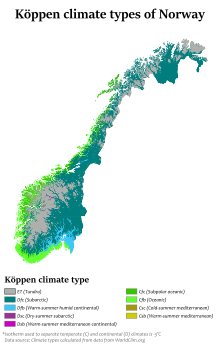Veggfjellan
| Veggfjellan | |
|---|---|
 View of Veggfjellan from Kråkmo Mountain | |
| Highest point | |
| Elevation | 938 m (3,077 ft) |
| Naming | |
| English translation | "Wall Mountain" |
| Geography | |
| Parent range | Scandinavian Mountains |
Veggfjellan is a 3,076-foot (938 meter)-high mountain in Nordland, Norway, located to the south of Sagfjorden in Hamarøy.[1] The Steigen tunnel (Nordland 830) passes under it.[1][2]
Etymology[edit]
"Fjell" means mountain, while "Vegg" means wall. So, the mountain translates to "Wall Mountain" in Norwegian.[3][4]
Geography[edit]

Veggfjellan is located within the Scandinavian Mountains in far northern Nordland, Norway, near Drag.[2][5] It is relatively low for a mountain, at less than 1,000 meters.[2] It is also on Finnøya island to the southeast-east of Lofoten.[5]
Climate[edit]
The mountain is well within the subarctic (Dfc) climate zone, with only two months averaging above 10 C (50 F), three months averaging at or below -3 C (27 F), and five months averaging at or below 0 C (32 F).[6] This is abnormally cold for Nordland, but the elevation may play a part in this mountain's climate. Snow is common in winter, averaging 84 days per year, with January, February and March averaging two weeks in terms of snow days, and the summer months plus June averaging none.[6]
The climate, though cold for Norway, is still very moderated (and with somewhat less snow) compared to cities at the same latitude line (Kaktovik, Alaska; Inuvik, Northwest Territories, Canada), and even much further south (Kuujjuaq, Quebec, Canada; Harbin, Manchuria, China), due to Gulf Stream moderation that turns places like Kristiansund, Bergen, and Molde, Norway to temperate Cfb's.[6]
| Month | Jan | Feb | Mar | Apr | May | Jun | Jul | Aug | Sep | Oct | Nov | Dec | Year |
|---|---|---|---|---|---|---|---|---|---|---|---|---|---|
| Record high C (F) | 8 (47) | 8 (46) | 11 (51) | 18 (64) | 29 (83) | 30 (85) | 32 (89) | 30 (86) | 23 (73) | 18 (65) | 13 (55) | 9 (49) | 32 (89) |
| Average high C (F) | -1 (31) | -1 (30) | 1 (33) | 4 (39) | 8 (46) | 12 (54) | 16 (61) | 16 (60) | 12 (53) | 6 (42) | 2 (36) | 0 (32) | 6 (43) |
| Daliy mean C (F) | -3 (26) | -4 (25) | -2 (28) | 1 (33) | 5 (41) | 9 (49) | 13 (56) | 13 (55) | 9 (49) | 4 (39) | 0 (32) | -3 (27) | 3 (38) |
| Average low C (F) | -6 (21) | -6 (20) | -5 (23) | -2 (28) | 2 (36) | 7 (44) | 11 (51) | 10 (50) | 7 (44) | 2 (35) | -2 (28) | -5 (23) | 1 (34) |
| Record low C (F) | -23 (-10) | -24 (-12) | -22 (-7) | -14 (6) | -5 (23) | 1 (33) | 5 (41) | 1 (33) | -5 (22) | -12 (9) | -19 (-2) | -26 (-16) | -26 (-16) |
| Average rainfall in | 2.69 | 2.65 | 2.56 | 2.01 | 1.95 | 2.01 | 2.93 | 2.69 | 2.72 | 2.81 | 2.36 | 2.44 | 28.82 |
| Average snowy days | 15 | 15 | 14 | 10 | 4 | 0 | 0 | 0 | 0 | 5 | 9 | 12 | 84 |
Source:[6] (MSN)
Nature[edit]
White-tailed eagles, reindeer, and moose abound, as is common in most of Norway (reindeer do not live in the coastal south).[7]
See also[edit]
References[edit]
- ^ a b Thorsnæs, Geir (2023-01-25), "Veggfjellan", Store norske leksikon (in Norwegian), retrieved 2023-10-27
- ^ a b c "Veggfjellan".
- ^ "What does vegg mean in Norwegian?". WordHippo. Retrieved 2023-10-27.
- ^ "What does fjell mean in Norwegian?". WordHippo. Retrieved 2023-10-27.
- ^ a b "Bing Maps". Bing Maps. Retrieved 2023-10-27.
- ^ a b c d "MSN". www.msn.com. Retrieved 2023-10-27.
- ^ "nordland wildlife". Bing. Retrieved 2023-10-27.
